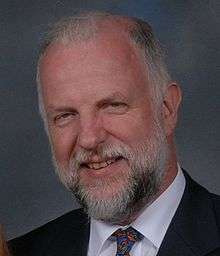Michael Howard Kay
| Michael Kay | |
|---|---|
 | |
| Born |
Michael Howard Kay 11 October 1951 Hannover, West Germany |
| Institutions | |
| Alma mater | Trinity College, Cambridge |
| Thesis | Data independence in database management systems (1976) |
| Doctoral advisor | Maurice Wilkes |
| Known for | Saxon XSLT |
| Spouse | Penelope M. Kay[1] |
|
Website | |
Michael Howard Kay Ph.D FBCS (born 11 October 1951) is the editor of the W3C specification of the XSLT 2.0 language for performing XML transformations,[2] and the developer of the Saxon XSLT and XQuery[3] processing software.[4][5][6][7]
Education
Kay was educated at Salesian College in Farnborough, and then went to Trinity College, Cambridge to read Natural Sciences. He gained his Doctor of Philosophy at the University of Cambridge Computer Laboratory under the supervision of Maurice Wilkes.[8]
Career
Kay has spent over twenty years (1977-2001) with the British computer manufacturer International Computers Limited (ICL). He was appointed an ICL Fellow in 1990. On leaving ICL, he worked for three years with Software AG[9] before forming his own company, Saxonica.[1][10][11] He has previously been involved in GedML: Genealogical Data in XML.[12]
Publications
Kay is the author of the book XSLT: Programmer's Reference by Wrox Press and several other books and papers[9][13][14][15] on software engineering.[16][17][18] He lives and works in Reading,[1] England and is a member of the XML Guild[19] and a regular speaker at the XML Summer School in Oxford[20] and Balisage Markup conference.[21]
References
- 1 2 3 4 Saxonica Limited
- ↑ Kay, Michael. "XSL Transformations (XSLT) Version 2.0". World Wide Web Consortium. Retrieved 2006-05-10.
- ↑ Kay, Michael (2008), "Ten Reasons Why Saxon XQuery is fast" (PDF), IEEE Data Eng. Bull., 31 (4): 65–74.
- ↑ Michael Howard Kay on Twitter
- ↑ Delpratt, O. N. D.; Kay, M. (2011). "The Effects of Bytecode Generation in XSLT and XQuery". Proceedings of Balisage: The Markup Conference 2011. Proceedings of Balisage: The Markup Conference 2011. 7. doi:10.4242/BalisageVol7.Delpratt01. ISBN 978-1-935958-03-1.
- ↑ Kay, M. (2010). "A Streaming XSLT Processor". Proceedings of Balisage: The Markup Conference 2010. Proceedings of Balisage: The Markup Conference 2010. 5. doi:10.4242/BalisageVol5.Kay01. ISBN 978-1-935958-01-7.
- ↑ Kay, M. (2009). "You Pull, I'll Push: On the Polarity of Pipelines". Proceedings of Balisage: The Markup Conference 2009. Proceedings of Balisage: The Markup Conference 2009. 3. doi:10.4242/BalisageVol3.Kay01. ISBN 0-9824344-2-1.
- ↑ Kay, Michael Howard (1976). Data independence in database management systems. (Ph.D thesis). University of Cambridge.
- 1 2 Kay, M. H. (2003). "XML five years on". Proceedings of the 2003 ACM symposium on Document engineering - DocEng '03. p. 29. doi:10.1145/958220.958221. ISBN 1581137249.
- ↑ http://www.stylusstudio.com/michael_kay.html An Interview with Michael Kay
- ↑ https://stackoverflow.com/users/415448/michael-kay Stackoverflow Profile of Michael Kay
- ↑ http://users.breathe.com/mhkay/gedml/ GedML
- ↑ Michael H. Kay at DBLP Bibliography Server
- ↑ Michael Howard Kay's publications indexed by the Scopus bibliographic database, a service provided by Elsevier. (subscription required)
- ↑ Michael Howard Kay from the ACM Digital Library
- ↑ Kay, Michael (1993), OPENframework Information Management, Prentice Hall, ISBN 0-13-630500-8
- ↑ Kay, Michael (2008), XSLT 2.0 and XPath 2.0 Programmer's Reference (4th ed.), Wrox, ISBN 0-470-19274-7
- ↑ Kay, Michael (2004), XSLT 2.0 Programmer's Reference (3rd ed.), Hungry Minds Inc., ISBN 0-7645-6909-0
- ↑ http://xmlguild.org/members The XML Guild: where you find established XML experts
- ↑ http://xmlsummerschool.com The XML Summer School, Oxford
- ↑ http://www.balisage.net Balisage: The Markup Conference
| Wikimedia Commons has media related to Michael Howard Kay. |